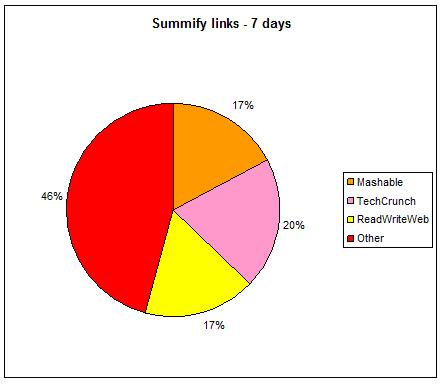I recently signed up for a new service called Summify that “creates a periodic summary of the most relevant news stories, from all of your social networks, and delivers it by email and on the web”. In short, Summify emails you links to stories that your network has shared during the last hours or days.
 When I first joined, I only connected my Twitter account to the service. After about one week I wanted to check what types of links Summify had sent me. I had chosen to get 5 links per day, but you can select another frequency and a different number of links. Turns out that a majority of the links are from TechCrunch, ReadWriteWeb and Mashable. In total, 19 out of 35 links are from these three sources.
When I first joined, I only connected my Twitter account to the service. After about one week I wanted to check what types of links Summify had sent me. I had chosen to get 5 links per day, but you can select another frequency and a different number of links. Turns out that a majority of the links are from TechCrunch, ReadWriteWeb and Mashable. In total, 19 out of 35 links are from these three sources.
For me, that is not very valuable. If you are the type of person that check Twitter on a regular basis, you will probably already have seen most of these stories. These three are among the most read social media and tech sites on the web so I have probably already seen the most interesting stuff from them. A typical link, like this one from Mashable, has been tweeted more than 1,400 times and shared 240 times on Facebook in less than a day. I had hoped that I would be exposed to links to stories that would be interesting to me, but that I probably hadn’t seen, not “most tweeted stories”.
On the other hand, you can use Summify as a filter to catch up on the stories that most people talk about. So if you are not a social media junkie who is on Twitter all day, Summify summarizes the most talked about stories, using your friends as a filter. Check Summify and you will be up to date with the latest news.
Now I have also added my Facebook and Google Reader accounts to Summify. Hopefully that will increase the number of sources that Summify sends to me. I will try to follow up this post in a few days to report if there has been any “improvement”.
Thanks for checking out Summify! It’s true that stories from the major blogs get lots of Tweets and shares across the web. Even though we use that as a lower priority signal than what your friends have shared, they still have a lot of echo within your network. We’re thinking about how to approach that.
Thanks for commenting Cristian. I guess it’s natural that these heavy-weights are over represented since so many people share their news. I will continue to see what stories Summify sends me now that I have included more sources. Or maybe I should just get some new friends 😉
Not a comment, but a question. How do you think Summify compares to other services of the same kind?
Hi Robert,
There are several ways to track the most shared stories. For example, sites like http://twitturls.com/ and http://www.tweetmeme.com track the most shared links on Twitter. But that is overall, and not filtered to display what your friends share, like Summify does.
Then you have sites like http://www.trunk.ly that tracks what links your friends save or share, but there is not “summary” like with Summify.
I’m sure I’ve forgotten tons of services, but as a means to track the most important stories from your network, Summify does it well.
Hans, Did you see any improvement of the results after adding facebook and google?
Possibly slightly more variation, but still, Mashable, TC, RWW and Social Media Examiner make up half of all links in my Summify feed.